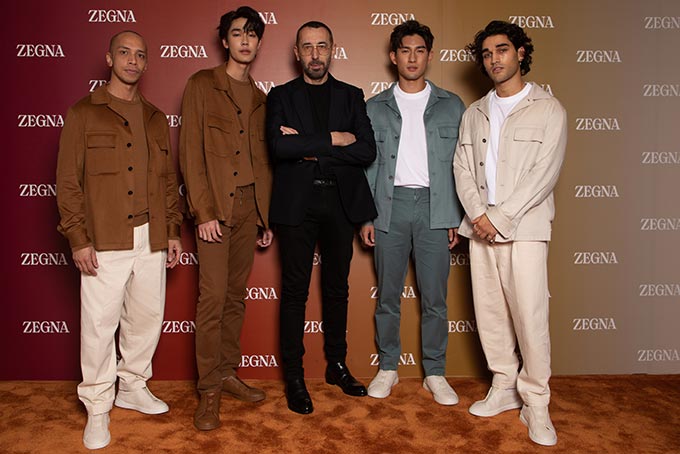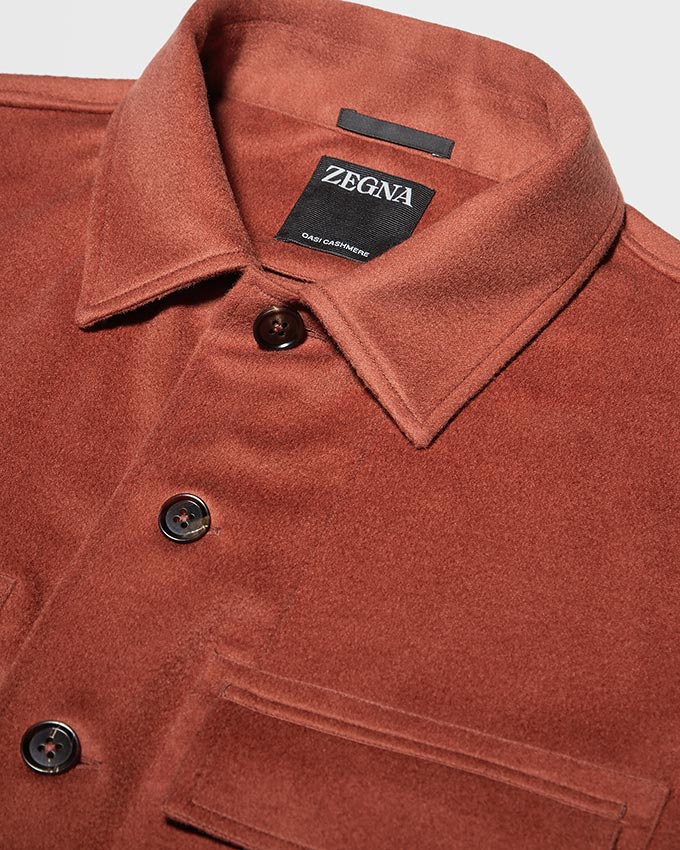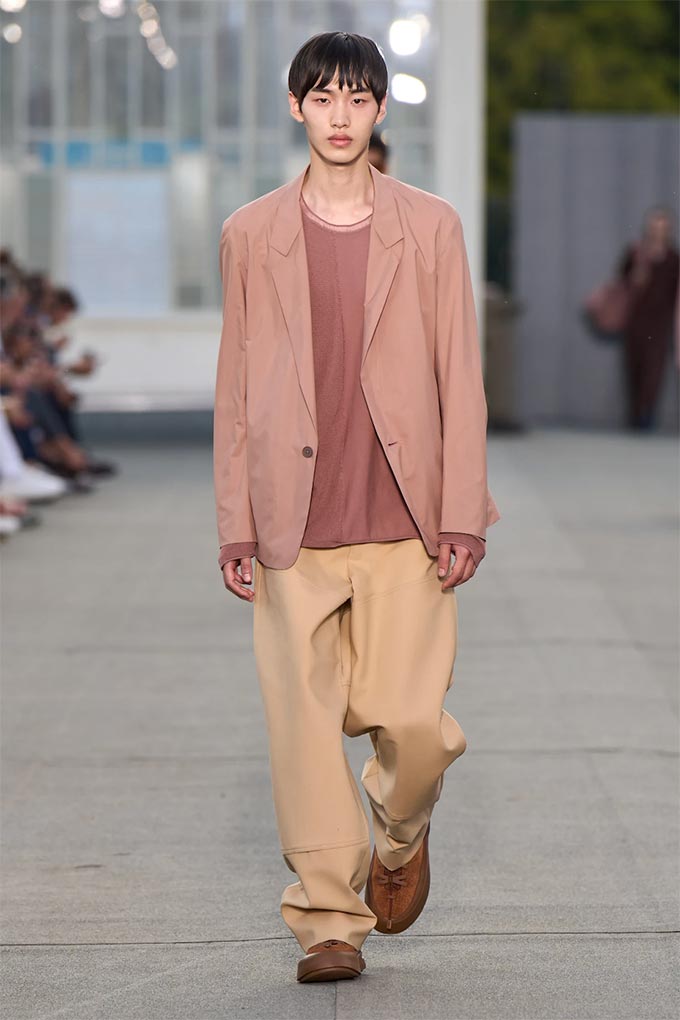Last weekend, our city was set ablaze by the highly-anticipated return of Formula 1, where a slew of renowned drivers, fast cars and exciting parties came to town. An event that was undisputedly an F1 highlight? The Zegna party at The Fullerton Hotel where the all-new Oasi Cashmere collection was presented, amidst the exhilarating environs of the race night with many famed names in attendance—including the brand’s artistic director Alessandro Sartori who was in town for the enchanting event. Ahead of the party, champers and fireworks that ensued, Vogue Singapore caught up with Sartori as he shared about his love for our city, the current state of menswear and his vision of conscious luxury.
Coming to Singapore for F1 sounds like it’s a big part of your annual calendar now.
Yeah, very much so. I enjoy the place very much. You know, there are cities where you feel you are just not at the right place, but you need to do it for work, and so you do it. On the opposite, I love this city. My favourites are Singapore, Los Angeles, and Lisbon—they all have a very beautiful climate.

Speaking of our climate, Singapore is a tropical warm country. As we celebrate Zegna’s Oasi Cashmere collection this evening, how do you recommend people in Singapore to wear cashmere?
I think that the summer season is just as important as winter. For countries like Singapore that have a consistent climate throughout the year—similar to Dubai and Miami—we are working on extending a special summer edition of our collection, to last throughout the year.
On the other hand, light cashmere, like the overshirt that you’re wearing now, is particularly important for these locations as they can be blended with everything else. It’s very good for being indoors. But maybe you wear a cotton T-shirt and cotton pants with a beautiful silhouette, and you use the Zegna cashmere overshirt as a new jacket. So I suggest using ultralight cashmere as the main piece over a blended silhouette.

The Oasi Cashmere is extremely comfortable—was comfort a key consideration brought on by the pandemic?
It’s the moment that comfort became a strong style key point. When people say: “Oh men are wearing joggers and T-shirts now; they don’t wear shirts anymore”. It’s not about that. It is the attitude of comfort, and that becoming part of your style. It could still be a very classic made-to-measure or bespoke suit, but the underpinnings or the fabrics are different. But what’s for sure is that comfort has now entered every angle of menswear and this is changing the paradigm of style that we are proposing for men.
We have seen how you have led Zegna in terms of combining tailoring with sportswear for a many years now and, as you just mentioned, how it’s now a big part of the fashion dialogue for menswear. As the world transitions past COVID-19, how do you think the Zegna man wants to dress? Are they still looking for comfortable loungewear or do they want to dress up again?
It is a very different equation as compared to the past. Because before, people would either wear a shirt and tie everyday, even on the weekends, and then there were other people who were very leisure-driven, even for celebrations.
Today, I think that the most important thing during the day is not classic wear anymore. It’s not classic suiting with a shirt and tie. It’s more of a form of elegant leisurewear. That means that you are combining tailoring techniques in sportswear garments. This is seen through our Zegna overshirt. So the technique is not the shirt technique, it’s a partially-made jacket technique. More people are wearing elevated sportswear with the consciousness of craft and sustainability. It’s conscious luxury.


Conscious luxury. What does that mean to you?
First of all, a luxury outfit or garment is not actually related to the price of the garment. While there is a right price for each product, in the end, it’s more related to quality and craft, and not a matter of style. So luxury today is an elevated craft to me. Consciousness in luxury is another layer—you’re considering durability of fabrics, provenance of materials, together with construction and design that makes the garment timeless.
The combination of design and sustainability are obviously big aspects for Zegna.
The Zegna wardrobe today has moved away from classic business wear. For the everyday, we have conscious luxury as expressed through elevated leisurewear and, on the other hand, there’s also a new sort of tailoring that’s chic and classic; more to do with celebration. Special celebration outfits that bear a tailored silhouette. Think of our special blazers, tuxedos, special trousers and so on.
With the brand streamlining all lines into one label, how does that affect you as an artistic director? Not just the clothes you’ve created but the stores that you design?
First of all, on the design side, it’s much easier because there is one brand, one story, one signifier, one collection as compared to before where we had three lines and three collections—Zegna Couture, Ermenegildo Zegna and Z Zegna. Today, we decided that we go for one story, which is bolder. Of course, investments in one collection are easier to manage image-wise because it’s more consistent. For the last two and a half years, I’ve also overseen the brand’s visuals—which includes stores, design and store planning. The Zegna store in Paragon, Singapore, is one of my babies that carries the new retail vision.

The Zegna store in Paragon is covered by huge digital screens, which is extremely innovative and progressive.
And we’re creating videos specifically for these windows. There is a lot of work behind it because we are providing and producing this content.
It’s a great way to connect with your customers and to entice them into the store. For your fall/winter collection that’s in stores now, I loved how you showed unbuttoned asymmetric shirting billowing under a notch lapel blazer on the runway. What are other key silhouettes from your current collection?
I love the idea of playing with deconstructed wide garments because I like the idea of oversized leisurewear, but crafted from a very light material. So I would say the oversized knitwear, high drawstring collars and necklines, cashmere jumper and the cashmere overshirt you are wearing—all of these are part of the new line of silhouettes.

Your Triple Stitch sneakers continue to be a top seller. What other key accessories would you love for Zegna to be known for?
First of all, the Triple Stitch became a strong icon worldwide and now we have created its brothers. I collaborated with a friend of mine, Daniel Bailey, who’s a shoe designer, to create a special version of it. It has a big, bold triple stitch.
Yes and it has that drawstring detail at the top. Beautiful.
Now, we’re building another version of the Triple Stitch. It has a very relaxing feel, perfect for the summer; so we did the bolder version for a professional outfit and we are creating an ultralight version for casual occasions. But the Triple Stitch isn’t just a shoe, but family to us—our most important accessory. Now, we’re working on the new bag and our next show is going to be an important launch for accessories.





